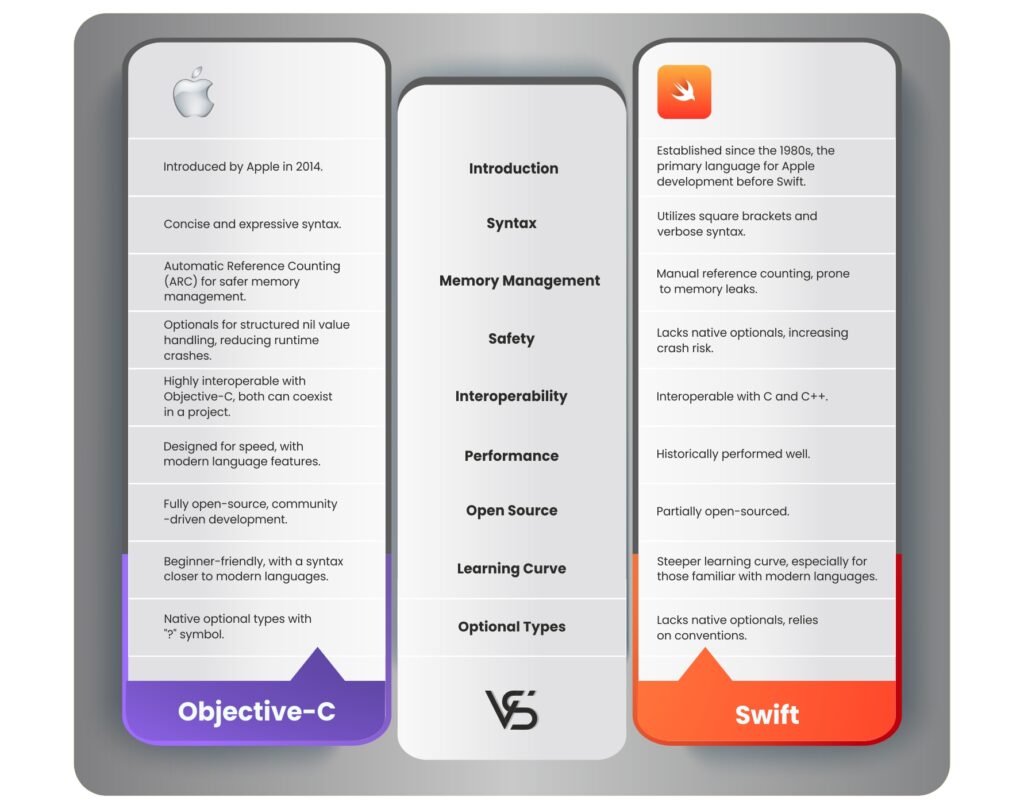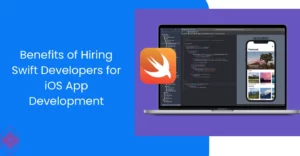Choosing the right programming language is crucial when starting iOS app development. Swift and Objective-C, two popular options, are competing for developers’ attention. In this article, we’ll compare these languages to assist you in finding the best fit for your app development needs.
What Is Swift?
Swift is a modern programming language, similar to JavaScript, Python, and C#. It’s known for being user-friendly, making it a favorite among today’s developers, especially when compared to Objective-C.
Swift’s journey began in 2010, and it became accessible to developers in 2014, after about four years of development. Since then, it has seen significant updates, with the latest being Swift 5.5.
Swift 5.3, for example, brought major improvements, including the introduction of Async/await, which allows for asynchronous functions, and Structured Concurrency, which offered new ways for developers to handle tasks more efficiently. Swift’s continuous evolution makes it a powerful and versatile language for modern app development.
What Is Objective C?
Objective-C is a straightforward computer programming language created in the 1980s to enhance object-oriented programming. It gained popularity and was used by NeXT Computer, Inc., and later, Apple adopted it as the standard language for iOS app development.
Objective-C is highly regarded by iOS app developers worldwide. It allows developers to easily work with complex object-oriented tasks. Over the years, it has evolved beyond its original form, with significant improvements.
One major difference from its predecessor, ANSI C, is the addition of new extensions. These extensions expand Objective-C’s capabilities, making it more powerful and versatile. Today, it remains a fundamental language for iOS app development.
The Difference Between Swift And Objective C Programming Language
When it comes to iOS app development, the choice between Swift and Objective-C is a crucial one. Let’s break down the pros and cons of each to help you decide which is the best option:

Historical Context
To make an informed decision, it’s essential to understand the historical context of Swift and Objective-C. Objective-C has long been the primary language for iOS development, with a rich heritage dating back to the origins of iOS. Swift, introduced by Apple, represents a modern alternative designed to address certain limitations of Objective-C.
Syntax and Readability
One of the key differentiators between Swift and Objective-C is their syntax and readability. Swift employs a clean, intuitive syntax that resembles natural language, making it more accessible and easier to read for developers. Objective-C, on the other hand, has a distinctive syntax that may require a steeper learning curve for newcomers.
Safety and Performance
Swift places a strong emphasis on safety and performance. Its type inference system and optional types contribute to code safety by reducing the likelihood of runtime errors. Additionally, Swift’s modern features lead to more efficient code execution, resulting in better app performance compared to Objective C.
Interoperability
Both Swift and Objective C can coexist within the same project, allowing developers to leverage existing Objective-C codebases while gradually incorporating Swift. This interoperability eases the transition to Swift, making it a viable choice for projects with existing Objective C components.
Learning Curve
Consideration should be given to the learning curve associated with each language. Swift’s clean syntax and modern features may make it more approachable for developers new to iOS app development. Objective-C, while powerful, may require additional time for developers to become proficient due to its unique syntax.
Long-term Viability
Apple’s continued support for both Swift and Objective C ensures their long-term viability. While Swift represents the future of iOS development, Objective-C remains a valid choice for maintaining and extending existing projects. Consider the specific requirements of your project when making a decision.
Industry Trends and Recommendations
When deciding between Swift and Objective C, it’s beneficial to consider current industry trends and expert recommendations. Factors such as project complexity, team expertise, and the need for legacy support should influence your choice of programming language.
So, which is the Best Option?
- For brand-new iOS projects, Swift is usually the way to go. Its modern features, safety measures, and performance advantages make it a top pick.
- If you have existing Objective-C code or need to manage a legacy project, Objective-C can be the practical choice. You won’t be starting from scratch, and it’s a good fit for maintaining older apps.
- Sometimes, a hybrid approach is the answer. You can use both Swift and Objective-C in the same project, leveraging the strengths of each language.
In the end, the best choice depends on your project’s specific needs, the code you’re already working with, and the experience and preferences of your development team. Swift is often the favorite for new projects, but Objective-C can still be a valuable tool in certain situations.
Conclusion
The decision between Swift and Objective-C hinges on a range of factors, including syntax preferences, project requirements, and team expertise. Swift offers a modern, safe, and efficient option, while Objective-C provides stability and interoperability with existing codebases. For those seeking to hire Swift developers, assessing the specific needs of the project and considering long-term goals will guide you in making an informed choice for your app development endeavors.

![You are currently viewing Swift vs. Objective-C [Updated 2024]:A Comparison Guide](https://nextupgrad.com/wp-content/uploads/2023/11/Swift-vs.-Objective-C.webp)


